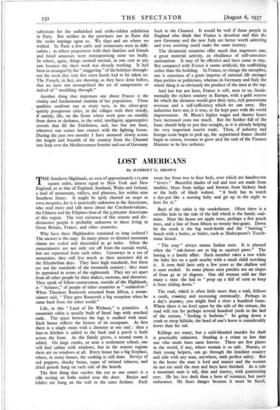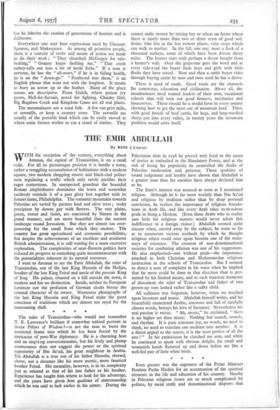LOST AMERICANS
By HARRIET G. BROWN THE Southern Highlands, an area of approximately r 12,000 square miles, almost equal to New York and New England, or to that of England, Scotland, Wales and Ireland, a land of mountains, valleys, and plateaus, lies within nine Southern States. It might be aptly charted on maps as terra incognita, for it is practically unknown to the Americans, who read more and talk more about the Czechoslovakians, the Chinese and the Filipinos than of the 3,000,000 Americans of this region. The very existence of this remote and dis- distinctive people is probably unknown to those living in Great Britain, France, and other countries.
Why have these Highlanders remained so long isolated ? The answer is the map. In many places to distinct mountain chains are scaled and descended in 40 miles. Often the mountaineers are not only cut off from the outside world, but are separated from each other. Castaways in a sea of mountains, they still live much as their ancestors did in the Elizabethan days. They have high standards, but these arc not the standards of the twentieth century ; they must be appraised in terms of the eighteenth. They are set apart from all other people by their dialect, customs, and character. They speak of fellow-countrymen, outside of the Highlands, as " furiners," of people of other countries as " outlanders." When Theodore Roosevelt returned from Africa, a moun- taineer said, " They gave Roosevelt a big reception when he came back from the other world."
Life, in this " Land of Do Without," is primitive. A mountain cabin is usually built of faced logs with notched ends. The space between the logs is caulked with mud. Each house reflects the history of its occupants. At first there is a single room with a chimney at one end ; then a lean-to kitchen is added to the back and a porch is built across the front. As the family grows, a second room is added. On large creeks, or near a settlement school, one will find cabins with windows, but in the remote regions there are no windows at all. Every house has a big fireplace, where, in many homes, the cooking is still done. Strings of red peppers, shucky beans, ropes of twisted tobacco, and dried gourds hang on each side of the hearth.
The first thing that catches the eye as one enters is a rifle resting on forks nailed near the door. Banjos and fiddles are hung on the wall in the same fashion. Each room has from two to four beds, over which are handwoven " kivers." Beautiful shades of red and rose are made from madder, blues from indigo and browns from hickory bark or the hulls of black walnut. " A body has to watch a dye-pot like a nursing baby and git up in the night to keer for it."
Back of the cabin is the smokehouse. Often there is a cavelike hole in the side of the hill which is the family coal- mine. Near the house are apple trees, perhaps a few peach trees, and a line of from fifteen to twenty bee-gums. Down by the creek is the big wash-kettle and the " battling " bench with a bailer, or batlet, such as Shakespeare's Touch- stone kissed.
" The crop " always means Indian corn. It is planted when the " oak-leaves are as big as squirrel paws." The hoeing is a family affair. Each member takes a row while the baby lies on a quilt nearby with a small child watching it. A corn field lasts only a few years as the shallow soil is soon eroded. In some places corn patches are on slopes of from 45 to 5o degrees. One old woman told me that many a time she had to " prop up a hill of corn to keep it from sliding down."
The road, which is often little more than a trail, follows a creek, crossing and recrossing continually. Perhaps in a day's journey, you might ford a river a hundred times. Where there is no level space by the side of the stream, the road will run for perhaps several hundred yards in the bed of the stream, " fording it bedwise." In going down a creek or steep hillside, the head of one's horse is considerably lower than his tail.
Killings are many, but a cold-blooded murder for theft is practically unknown. Stealing is a crime so low that one who steals loses caste forever. There are few places in the world, if any, where woman is so safe. Nurses, or their young helpers, can go through the loneliest country and ride with any man, anywhere, with perfect safety. But in the home the man is lord and master and the women do not eat until the men and boys have finished. As a rule a mountain man is tall, thin and sinewy, with penetrating eyes. He has less dash than a hero of romance, but more endurance. He faces danger because it must be faced, but he inherits the caution of generations of hunters and deliberate.
Everywhere one may hear expressions used by Chaucer. Spenser, and Shakespeare. As among all primitive people, there is a scarcity of verbs and nouns of action are made to do their work ; " They churched McGregor for tale- bearing," " Granny keeps faulting me," " That creek turkey-tails out into a lot of leetle forks." If a man is nervous, he has the " all-overs," if he is in failing health, be is on the " down-go." " Feathered into them," is an English phrase that went out with the kingbow. It means to bury an arrow up to the feather. Many of the place names are descriptive. Pizen Gulch, where poison ivy grows, Hell-fer-Sartain, noted for fighting. Chunky Girl, Big Bugaboo Creek and Kingdom Come are all real places.
The mountaineers are a rural folk. A few run grist mills, or sawmills, or keep a country store. The sawmills are usually of the portable kind which can be easily moved to where some farmer wishes to cut a stand of timber. They cannot make money by raising hay or wheat on farms where there is rarely more than two or three acres of good soil. Some, who live in the less remote places, raise crops which can walk to market. In the fall, one may meet a flock of a thousand turkeys, some of which have been driven thirty miles. The buyers start with perhaps a dozen bought from a farmer's wife. Over the grapevine goes the word and at every side-road the buyer finds boys and girls with little flocks they have raised. Now and then a cattle buyer rides through buying cattle by ones and twos until he has a drove.
There is need of roads. Good roads are the channels for commerce, education and civilisation. Above all, the mountaineers need trained leaders of their own, vocational schools that will turn out good farmers, mechanics and housewives. There should be a model farm in every county showing how to get the most out of mountain land. Then, with good breeds of beef cattle, fat hogs, and long-woolled sheep put into every valley, in twenty years the mountain problem would solve itself.







































 Previous page
Previous page